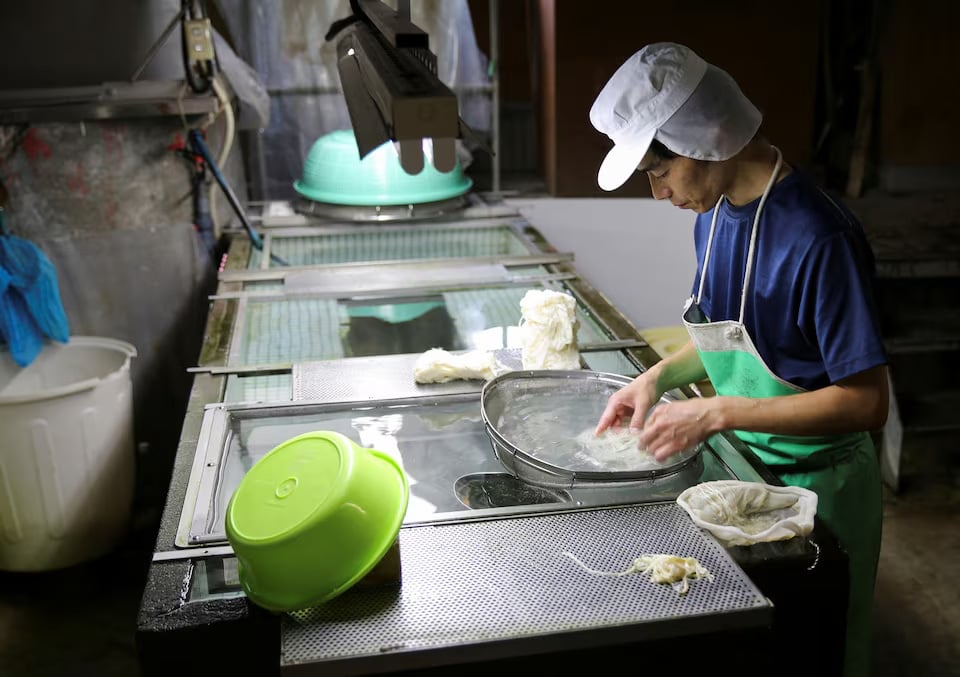Research firm Teikoku Databank said that in the first half of 2024 alone, the number of companies that went bankrupt due to labor shortages reached a record 182, up 66% from the same period last year.

A worker removes impurities from raw paper materials at the Kashiki Seishi Traditional Washi Paper Factory in Ino, Kochi Prefecture, Japan August 9, 2024 - Photo: REUTERS
According to Reuters news agency on December 20, Japan is facing an increasingly serious labor crisis, threatening the existence of traditional businesses and industries in small towns.
Struggling with labor shortage
In the town of Ino, Kochi Prefecture, known for its traditional papermaking industry, small businesses are struggling to survive.
Mr. Masato Shiota, president of Wako Seishi, a company that produces toilet paper and disinfectant wipes, said he could not operate at full capacity due to a lack of manpower.
“We have three machines but can only operate two a day. Without enough people, we can’t produce, we can’t make a profit and the company will collapse,” said Mr. Shiota.
Small and medium-sized enterprises, which account for 70 percent of jobs in Japan, are under great pressure from labor shortages.
According to research by the Recruit Works Institute , the land of cherry blossoms will have a shortage of 3.4 million workers by the end of this decade, and could reach a shortage of up to 11 million workers by 2040.

Mr. Yasushi Miyamoto (70 years old) is preparing a local specialty dish in Ino, grilled tuna over a hay fire, August 10, 2024 - Photo: REUTERS
Consider hiring high school graduates
Japan has also long restricted large-scale immigration, although some companies have hired short-term workers from countries such as Vietnam and the Philippines. However, the weak yen has made Japan less attractive to foreign workers.
In response, many companies have invested in automation to reduce their reliance on workers. For example, Wako Seishi Company spent more than 80 million yen to upgrade its production lines. However, high operating costs make it difficult for them to raise wages to retain workers.
At Toyo Tokushi, an adult diaper manufacturer in Ino, CEO Kei Moriki is considering hiring high school graduates — something that has never happened in the company’s history — to address the labor shortage. However, he worries that he doesn’t have enough resources to train young, inexperienced workers.
Kashiki Seishi, a long-standing handmade washi paper maker in Ino, used to rely on local farmers for labor. However, the number of farmers has dwindled, forcing the company to rely on volunteer labor.
"If there is no change, in the next 10 years there may be no one left to do this job," said Kashiki Seishi director Hiromasa Hamada.
Research firm Teikoku Databank said that in the first half of 2024 alone, the number of companies that went bankrupt due to labor shortages reached a record 182, up 66% from the same period last year.
The phenomenon could cause a domino effect, affecting supply chains and leading to "a wave of bankruptcies or mergers," said Takayasu Otomo, a researcher at Teikoku Databank.
The total number of bankruptcies is expected to surpass 10,000 this year, the highest level since 2013, according to data from Tokyo Shoko Research.
Amid a rapidly aging population, Japan needs a more comprehensive strategy to sustain small businesses, protect traditional industries and secure the future of rural towns from extinction.
Source: https://tuoitre.vn/thieu-lao-dong-hang-loat-cong-ty-o-nhat-ban-bi-pha-san-20241220125903658.htm



![[Photo] Prime Minister Pham Minh Chinh chairs a special Government meeting on the arrangement of administrative units at all levels.](https://vphoto.vietnam.vn/thumb/1200x675/vietnam/resource/IMAGE/2025/5/9/6a22e6a997424870abfb39817bb9bb6c)
![[Photo] Magical moment of double five-colored clouds on Ba Den mountain on the day of the Buddha's relic procession](https://vphoto.vietnam.vn/thumb/1200x675/vietnam/resource/IMAGE/2025/5/9/7a710556965c413397f9e38ac9708d2f)

































































































Comment (0)